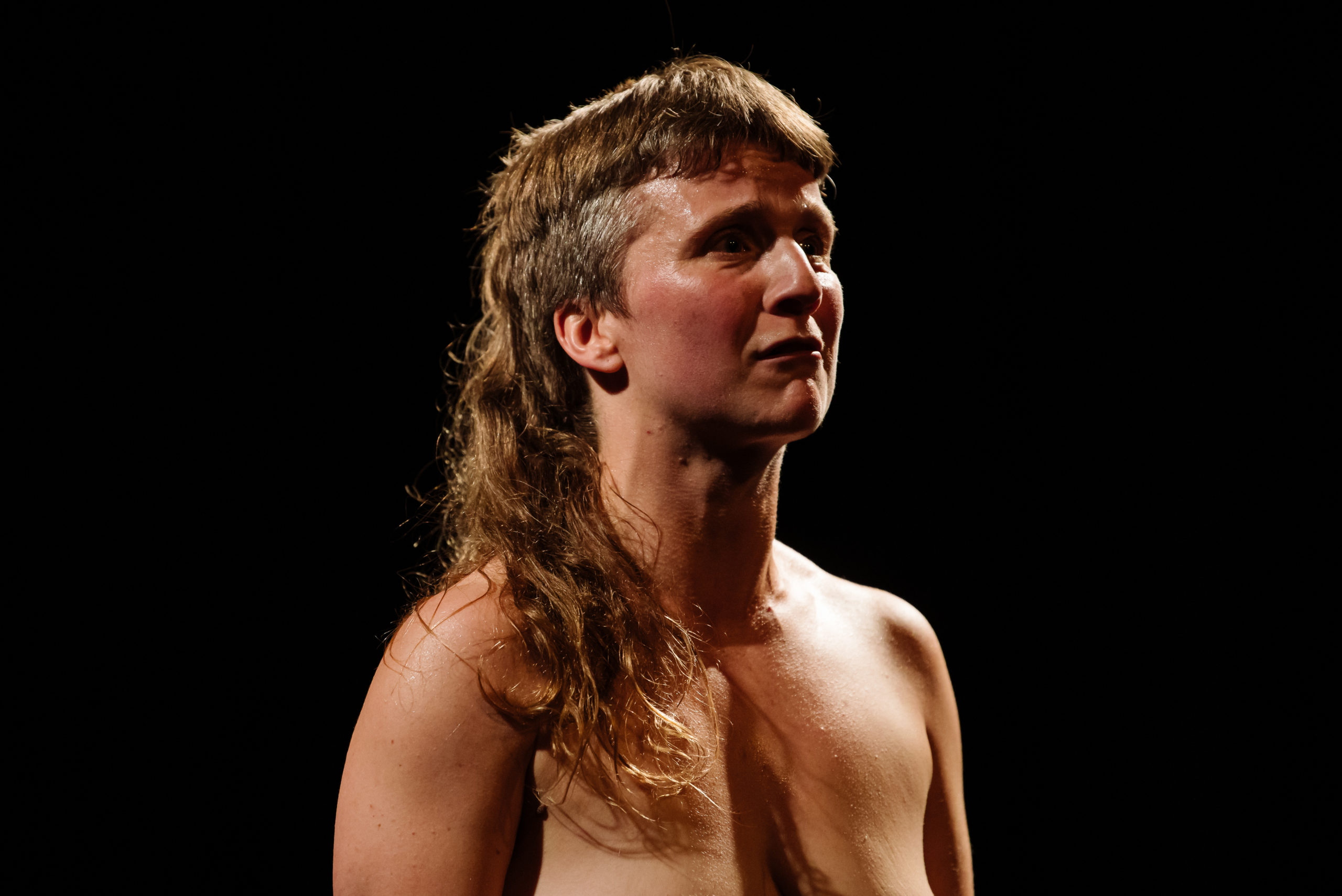DAJ writer Hannah Draper speaks to artist Sarah Hopfinger about Sarah’s work Pain and I, a piece which explores what it’s like to live with chronic pain.
“The piece is looking after me“
The beginning of the piece starts with an empty stage, as Sarah’s recorded voice welcomes the audience into the space, reassuring them that they can act as they want – they can respond to their needs; leave and come back, move, stim, close their eyes – they do not need to be a ‘polite viewer’. Sarah describes this as an “invite for me as well as for the audience”, something that I remember when I first saw the show in 2022 during its Fringe run.
Despite the piece inherently inviting a dialogue with Sarah’s ongoing experience of chronic pain, in my interview with her, I ask how she cares for herself while performing such a deeply personal piece in which she dances with and speaks to her naked body on stage. She replies, “the piece is looking after me”.
“What kind of piece would I make that was good for me?“
Sarah talks clearly and passionately about the creative process of the piece; words and thoughts unfolding as she speaks. A four year long process, Pain and I’s gestation period gave it the necessary space the work needed to grow and for the auto-biographical aspects to be handled slowly and sensitively, asking the question ‘what kind of piece would I make that was good for me?’
The work takes the format of an hour-long performance, a separate 30-minute audio piece made by Alicia Jane Turner, and a digital and physical graphic score, made in collaboration with photographer Brian Hartley and artists Rachel O’Neill and Michaela Pointon. Each are works in their own right – not ‘lesser versions’, nor Sarah’s translations or interpretations of the performance.
“When I started framing it as a relationship… I was able to go into that complexity easily.”
The piece takes the form of a conversation between Sarah and her body. She describes how the relationship with her chronic pain feels like a cycle of breaking up and falling back in love with her body. Sarah tells me that “when I started framing it as a relationship…I was able to go into that complexity easily.” We talk about the commitment to the unknown that all relationships require, and how the work became a way to start a conversation to learn from the uncertainty and unpredictable nature of pain and what could be learnt from listening to this in her body.
Sarah then went on to reflect on vulnerability in this project. “What has felt stronger than vulnerability maybe, in the whole project, has actually been…a sense of relief that I was able to turn towards all this stuff. Because actually, it was more vulnerable not doing it…pretending that I didn’t have chronic pain or just feeling shameful about it or feeling like I don’t know how to bring it into my practice.”
Initially only intended to be a movement piece, Pain and I reverberates with repetitive movement and text. Spoken and danced with different intonations that shift the meaning of the words, building tension and energy which is then softly released and broken with a smile, a long breath, sigh, exhaustion, or stillness.
“What if I move as a practice of care for my body?“
Sarah describes the creation process as a dialogue between the page, herself, and her body. The movement practice came from building small, repetitive movements as a practice of care for the body – allowing it to grow, build, or soften as necessary. The repetition used in the text echoes this and arose from the movement practice. Each performance allows sections of improvised scores to find different patterns, lengths and endings. Alongside long-term collaborator and Lost Dog co-founder, Raquele Meseguer Zafe, Sarah has developed scores and movement practices for working with chronic pain and disability. These practices of care, slowness, and listening seep into the piece building what Sarah describes as “an atmosphere and qualities we’re not encouraged to feel” in contemporary capitalist societies and cultures.
“Be kind to the words“
For Sarah, defining the intentions for different parts of the performance oscillate between “welcoming the pain in” to “a declaration a fear of my own body”. These intentions formed part of the collaborative process with the composer Alicia. They became prompts for creating sound, and Sarah would also ask the music to “be kind to the words” or push against the movements. Instead of working with traditional scores, Alicia used marks and shapes as music notation which later inspired the graphic score. Pain and I focuses on making an internal experience, of not only pain but pleasure and joy, external. Sarah tells me the music feels crucial to this – both for the audience and for her as a performer. The original audio score was adapted for the live performance, allowing Sarah’s presence on stage to take a more prominent role which the music takes the place of in the audio piece.
“Where does this work need to go?“
Our conversation ends in thinking about the future of the piece. While the multiple versions of the work have already stretched the ways Pain and I can be experienced, the next thoughts are to widen where these can be accessed – installing the audio pieces and graphic scores in doctor’s surgeries or pain clinics and other non-art spaces for people with lived experience of chronic pain and chronic illness to access the work. Yet, as Sarah states at the beginning of the piece, Pain and I enables anyone to experience what might come from “the richness of listening to pain.”
Pain and I is being performed at The Place this week on Saturday 15th April at 7.30pm. Book here. Image credit: Tiu Makkonen.
